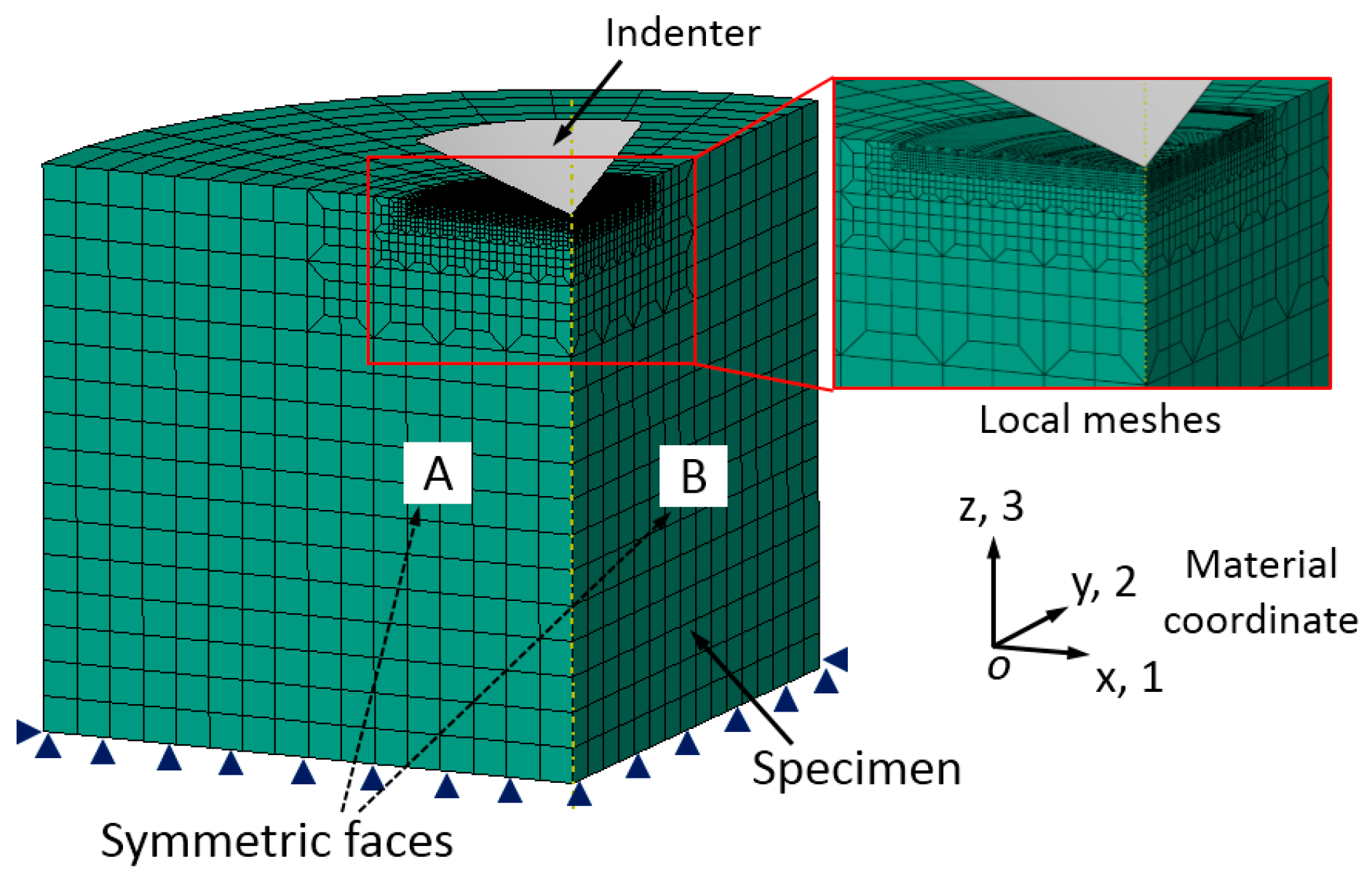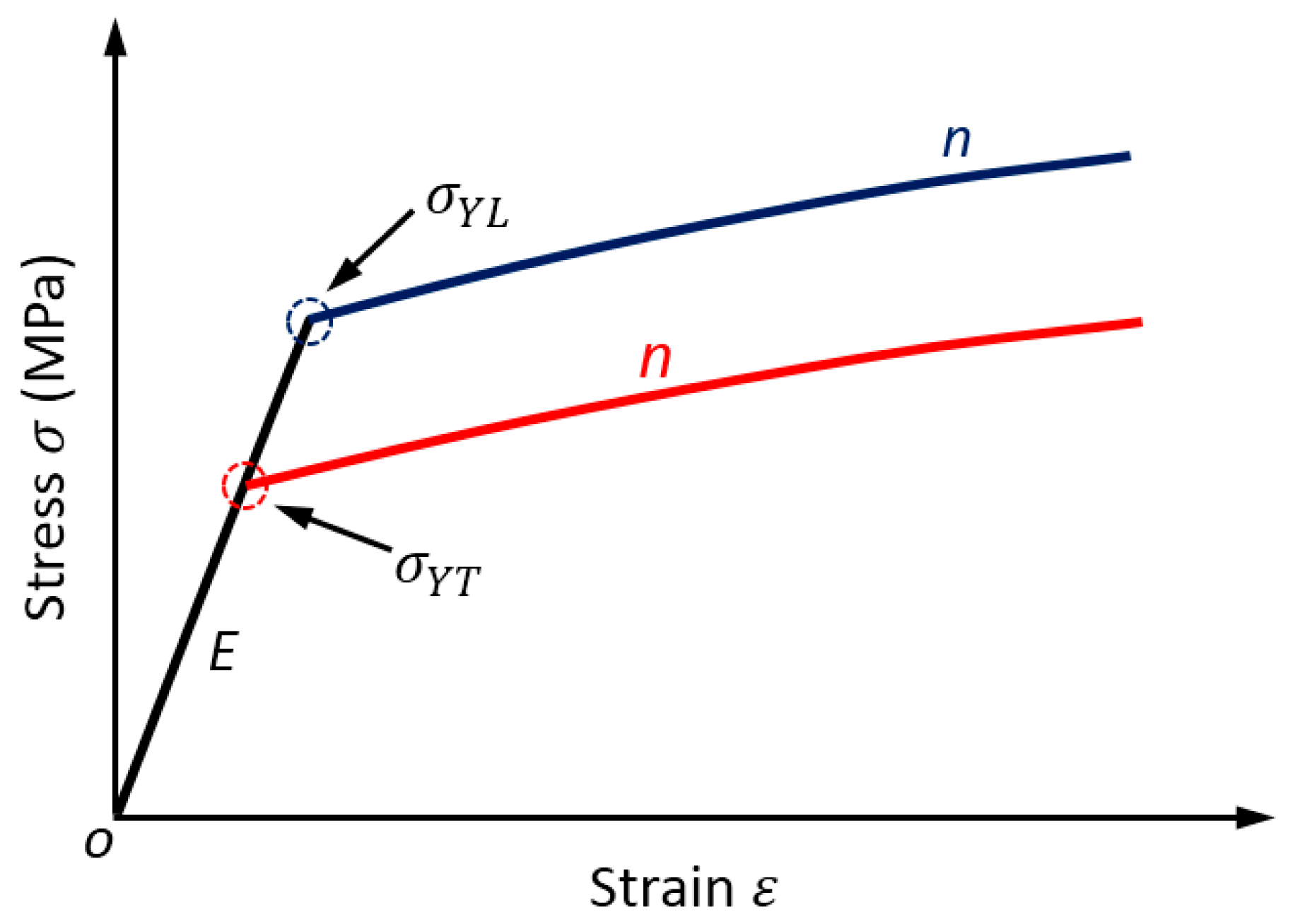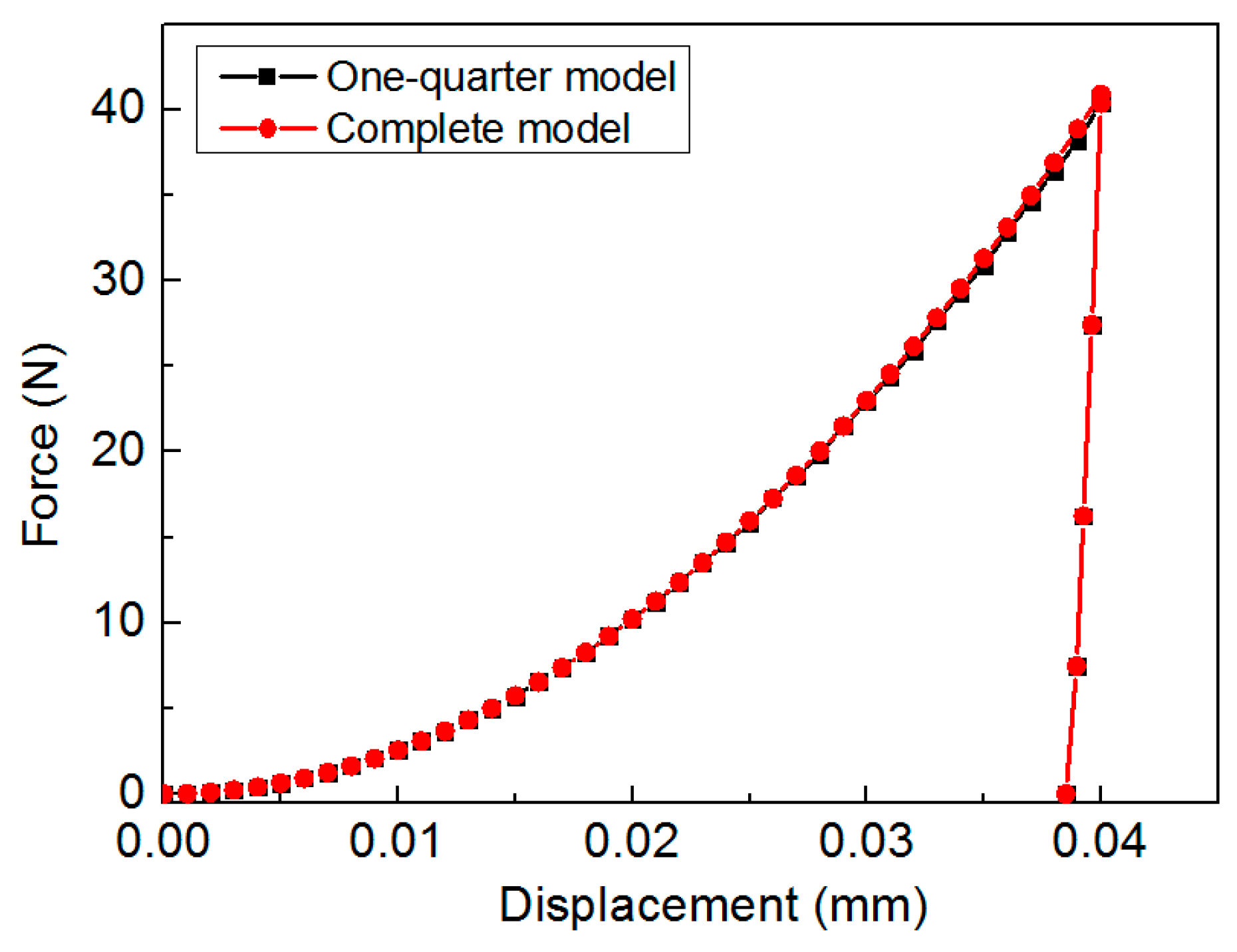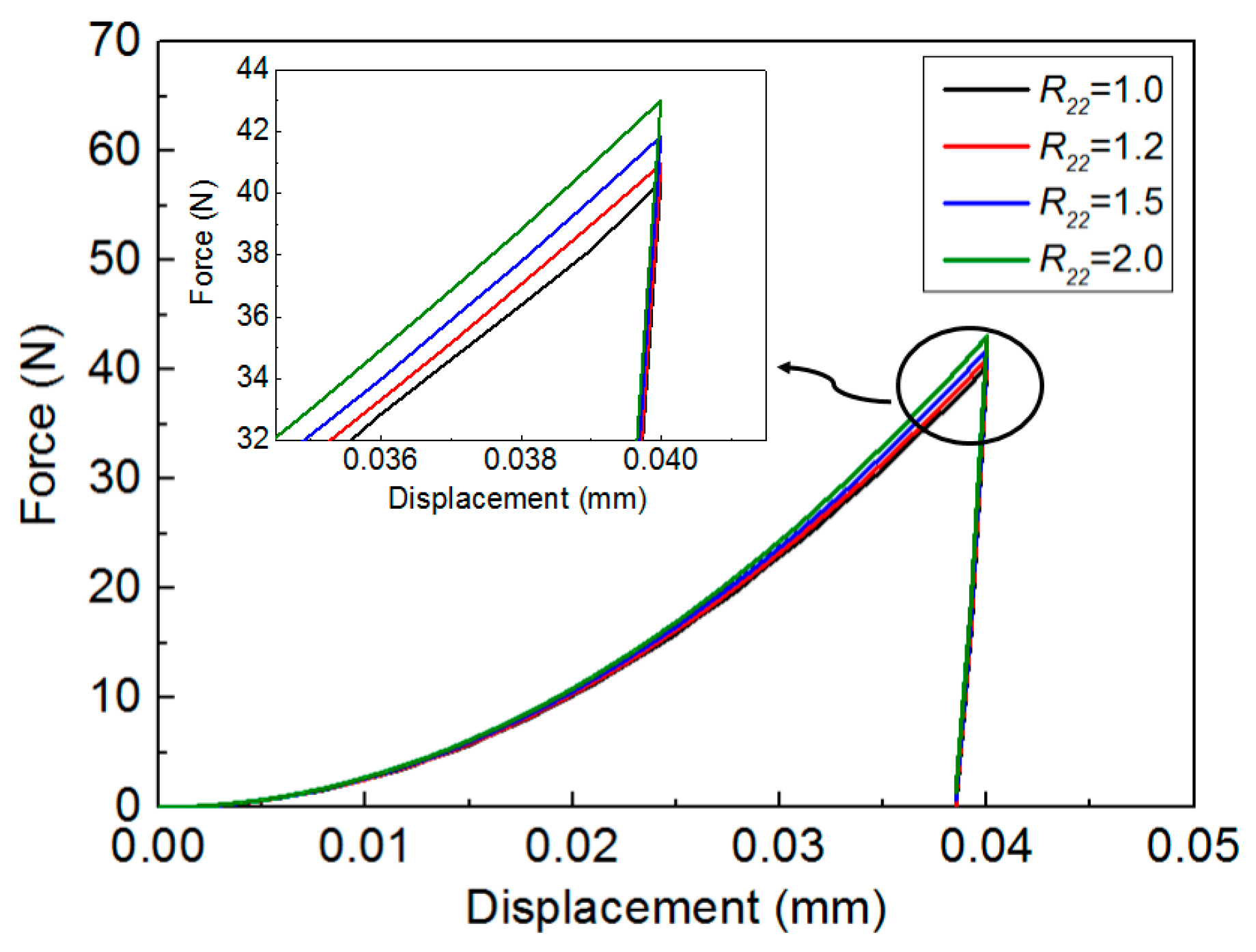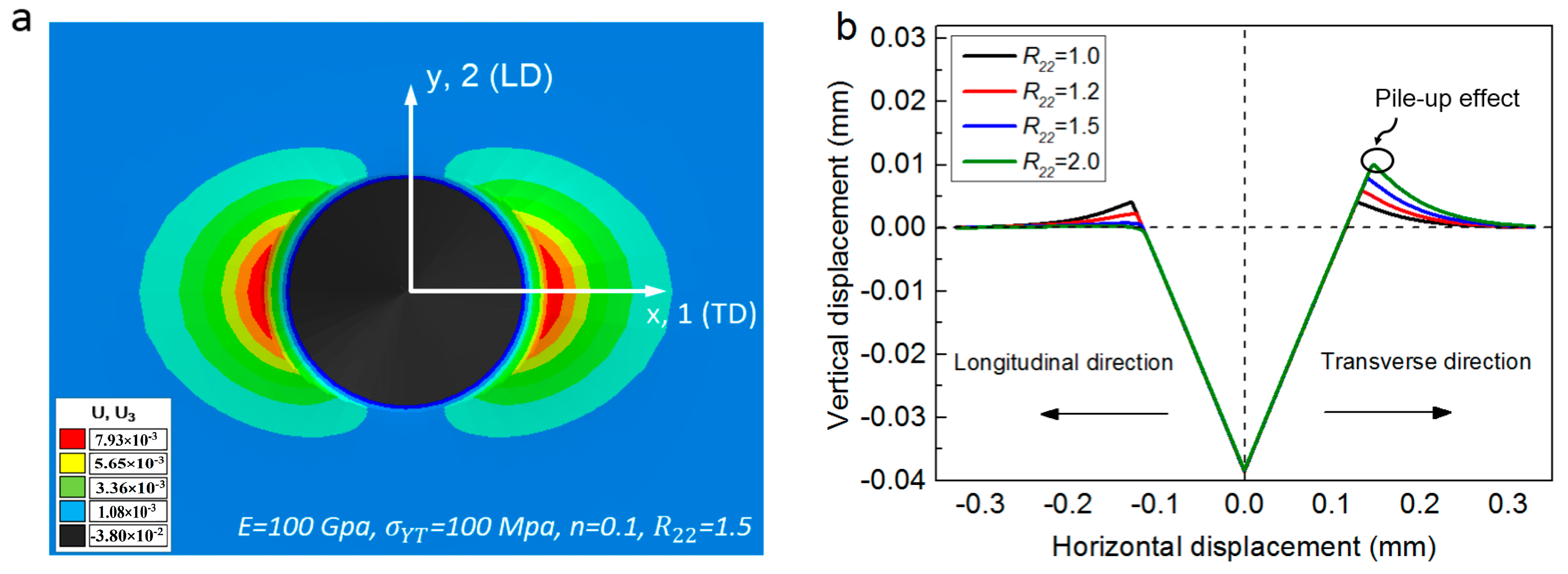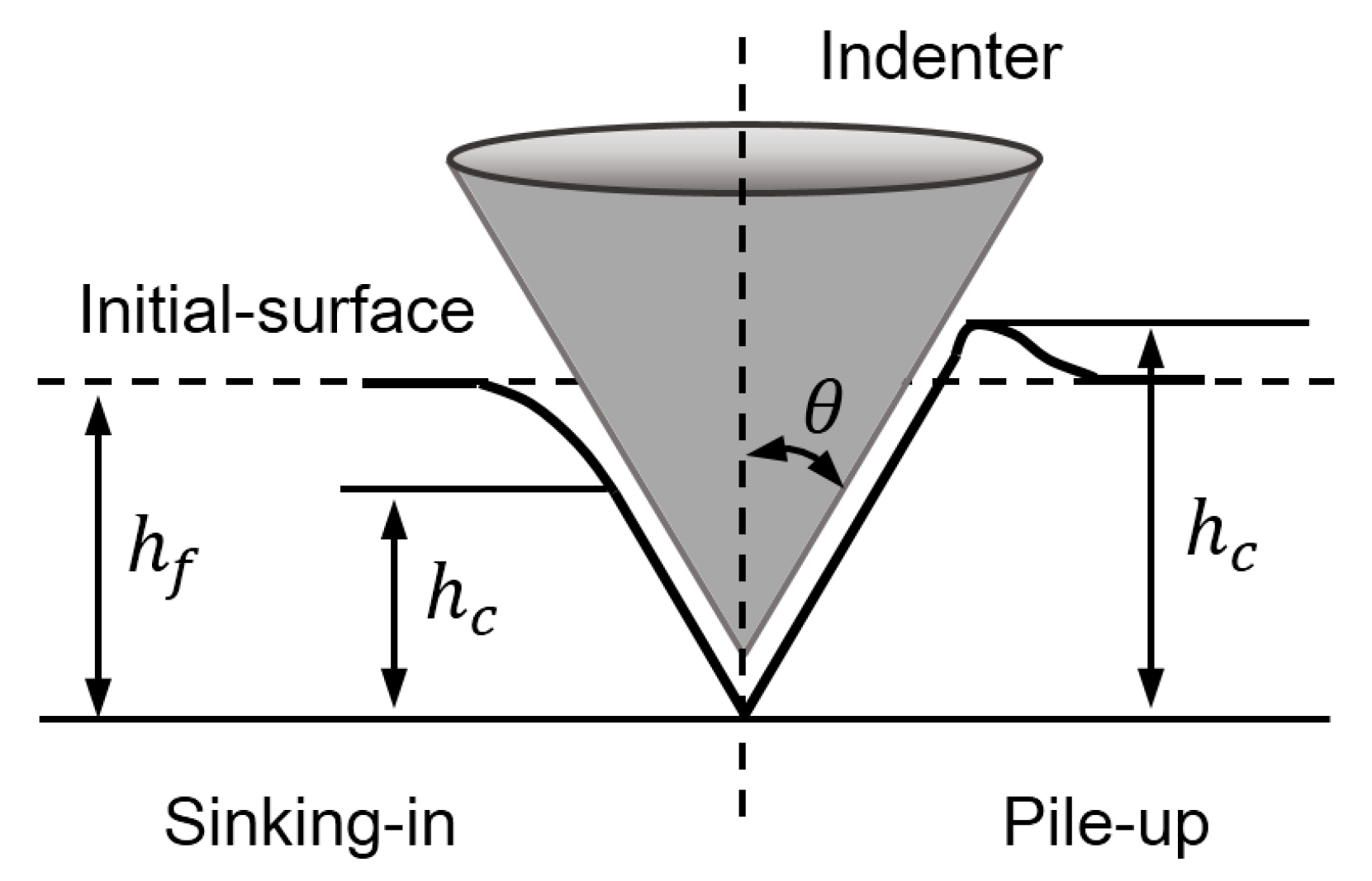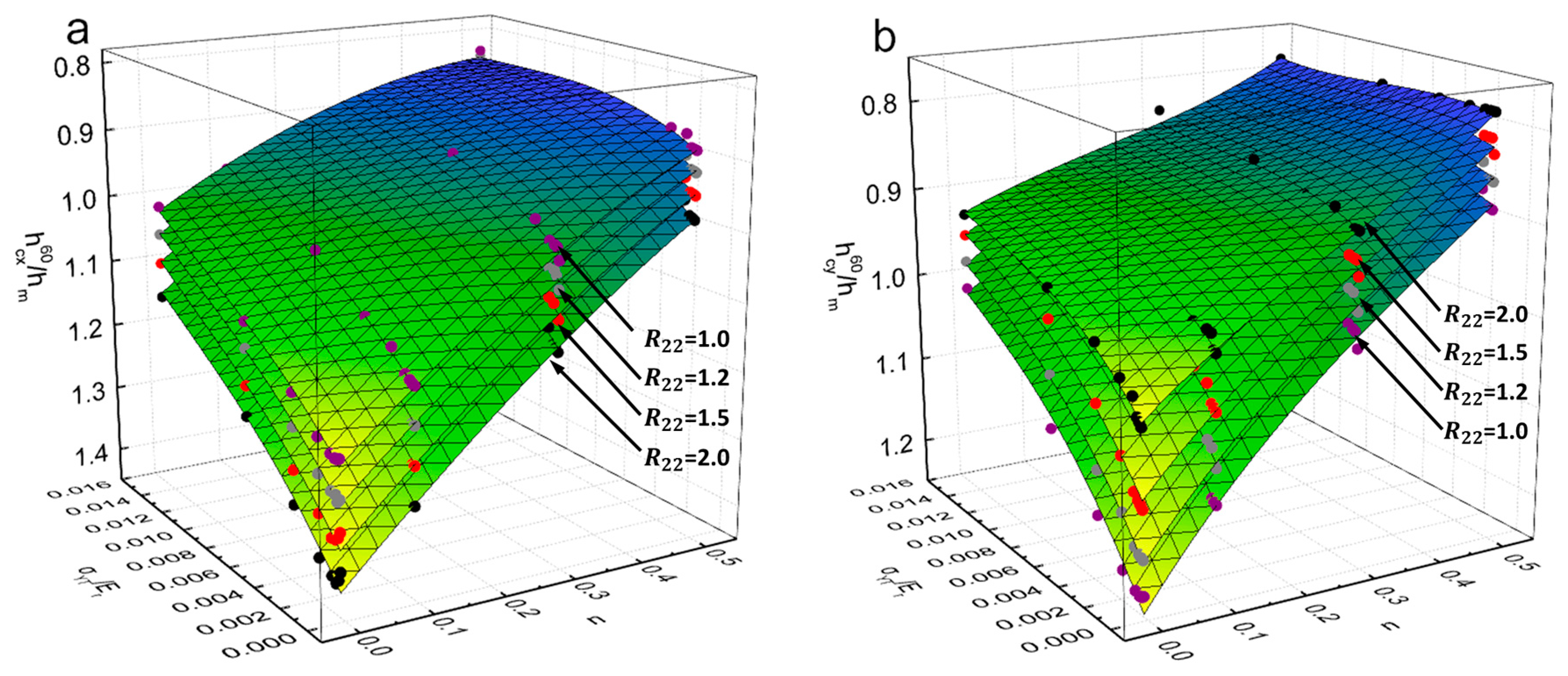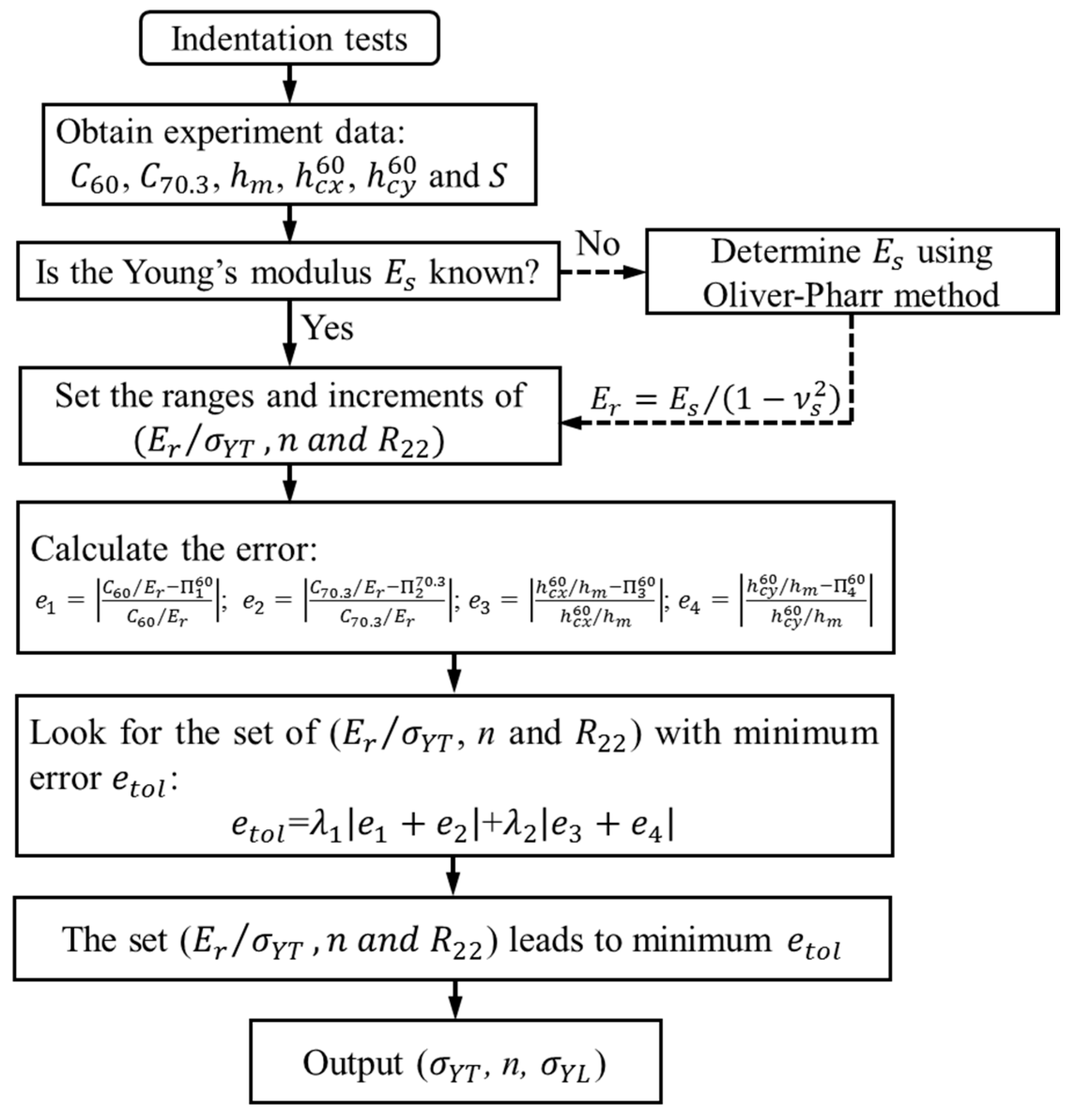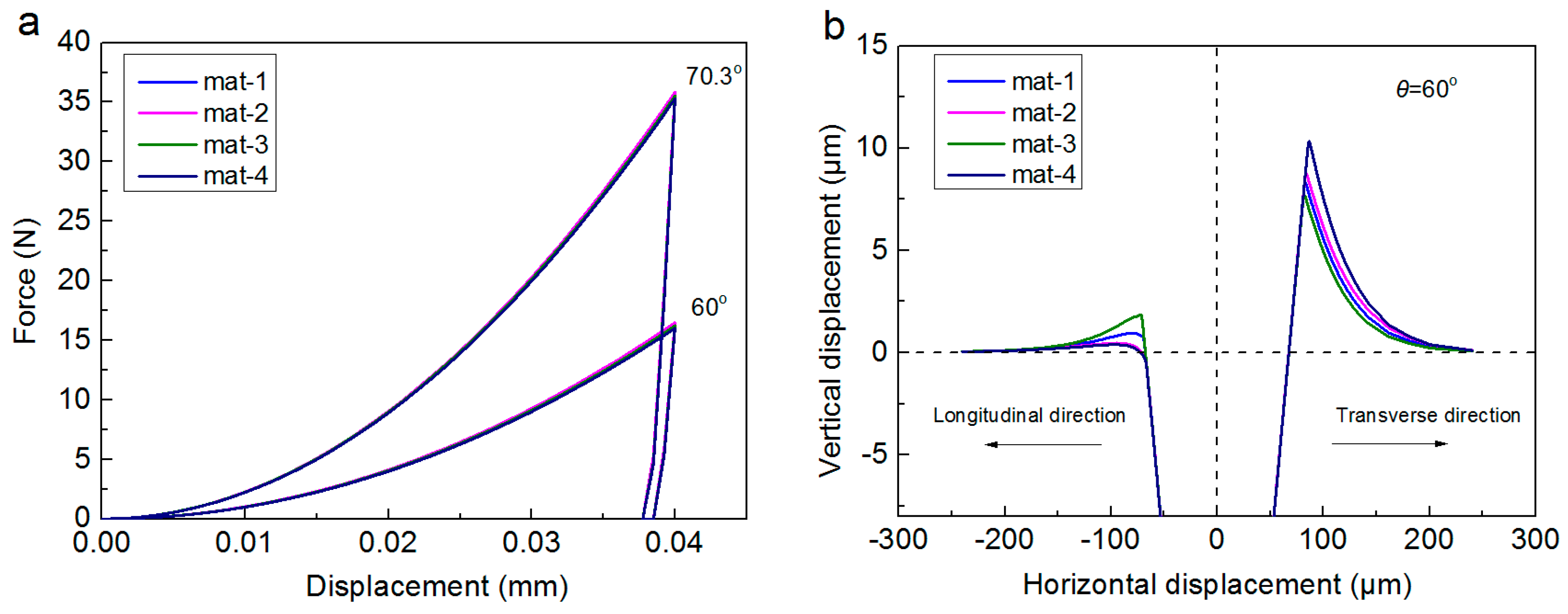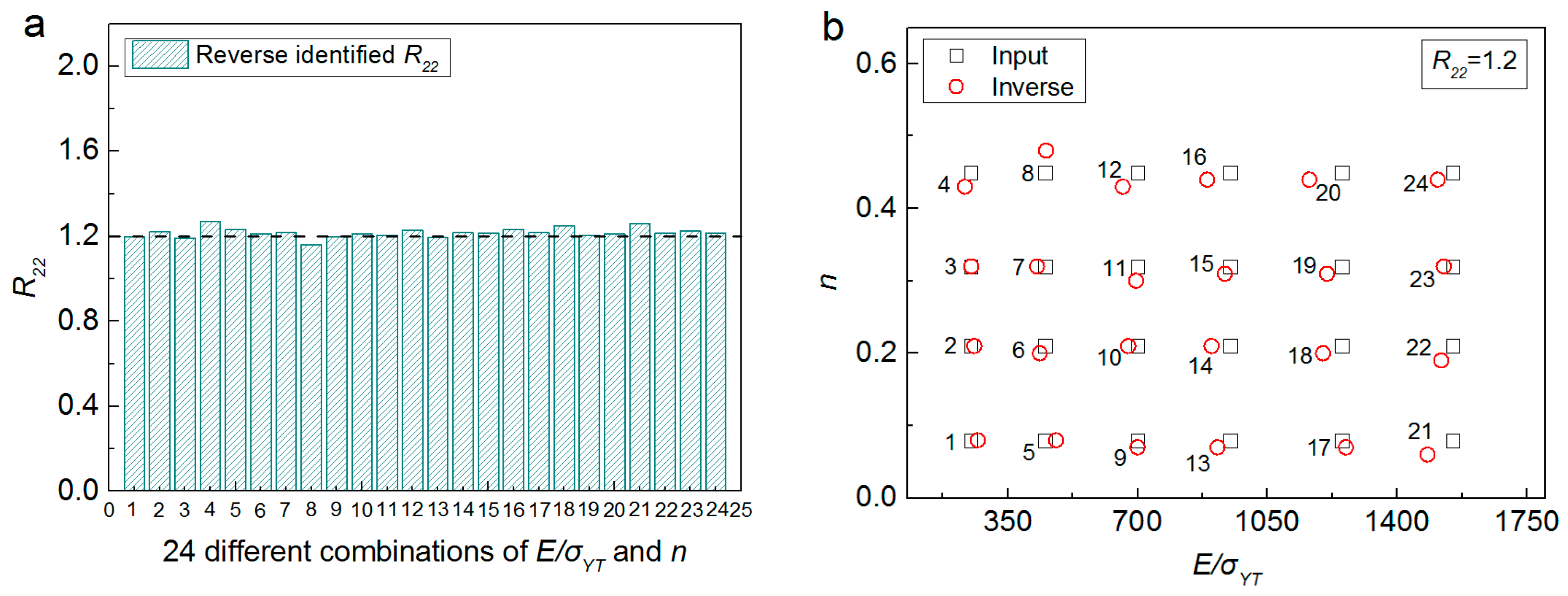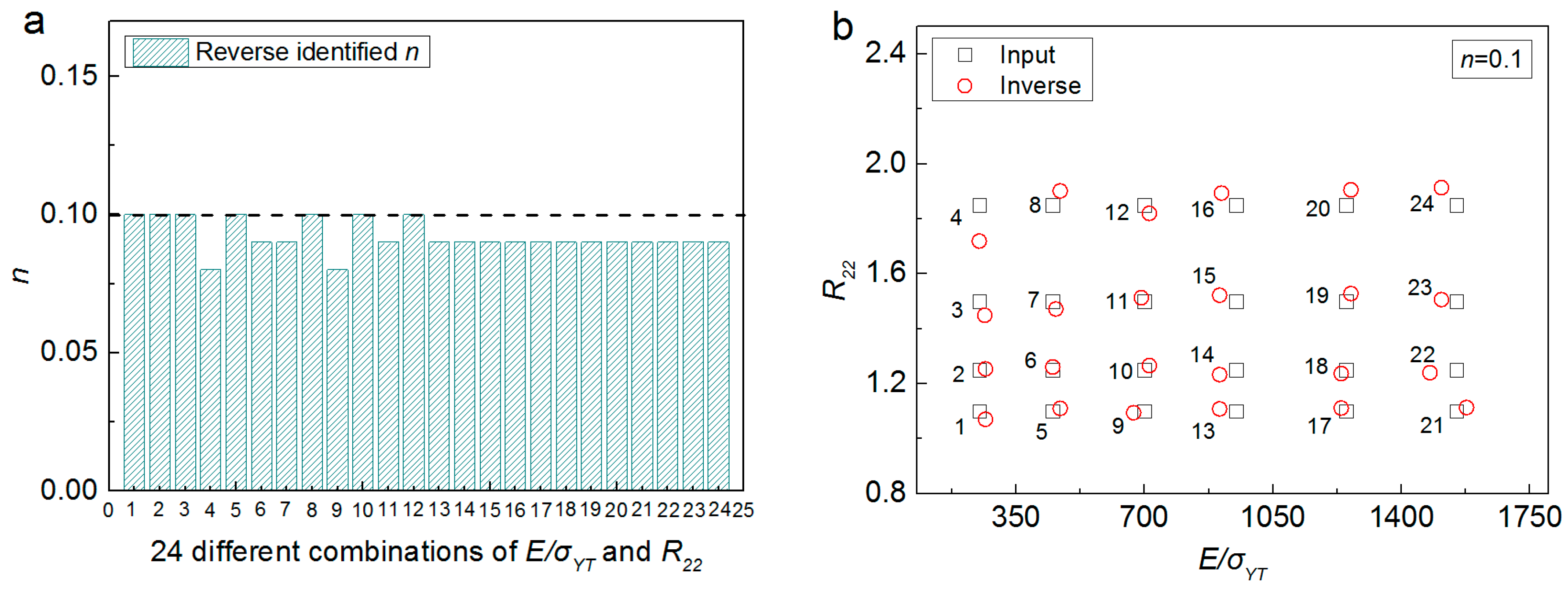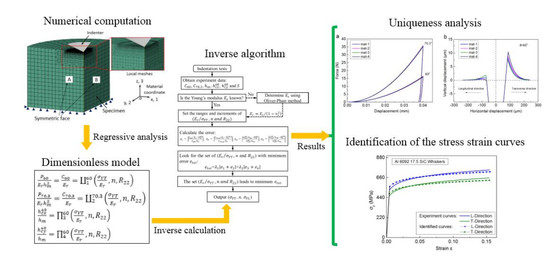4.1. Uniqueness of the Inverse Identified Set of Parameters Using Indentation and Inverse Analysis
In order to verify the effectiveness of the proposed inverse computation approach, and further interrogate the uniqueness of the inverse problem, using different experiment information (e.g., only the indentation P-h curves or both the indentation P-h curves and pile-up effect) in dual conical indentation tests, we first applied our numerical approach on the Al Castings 242.0-T21. In all the inverse parameters identification processes, the indentation shape factors are obtained by using the “pseudo-experiment”. The indentation response parameters (
,
,
,
and
) are obtained from FE analysis. Effectiveness of the method is verified by the direct comparison between the FE “Input” anisotropic parameters with those predicted by the proposed inverse computation approach. The advantage of using the “pseudo-experiment” as a replacement of real indentation experiment is that, it is able to circumvent the influence of some uncertain factors, e.g., experiment imprecision and material heterogeneity [
12,
14,
15]. Therefore, we are able to pay close attention to the nature of the inverse problem, e.g., well-posedness or ill-posedness.
The anisotropic parameters of Al Castings 242.0-T21, identified by indentation test and inverse analysis are listed in
Table 4 and
Table 5, respectively. The increments of material parameters in the inverse algorithm are defined as
= 2.5 MPa,
= 0.01 and
= 0.001. In the study, two different situations are considered. In situation one, only the P-h curves in dual conical indentation tests are used, and
= 1 and
= 0. Result obtained from this situation is listed in
Table 4. In situation two, both the indentation P-h curve and pile-up effect are considered, and
= 1 and
= 1. Result obtained from situation two is listed in
Table 5.
In order to fully investigate the uniqueness of the inverse identified anisotropic parameters, the set of (
,
n,
) with four minimum
values (in the ascent order) are recorded, as shown in
Table 4 (they are denoted as mat-1, mat-2, mat-3 and mat-4) for situation one and in
Table 5 (they are denoted as mat-5, mat-6, mat-7 and mat-8) for situation two, for the comparison purpose. It’s noted that, only the parameter set (
,
n,
) with the minimum
value is regarded as the inverse identified material parameters of the indented specimen.
As can be seen from
Table 4, that the inverse identified results are scattered in situation one. Four materials with different anisotropic parameters, exhibit very close
values, while their anisotropic parameters are completely different. This phenomenon is especially obvious, when the inverse identified parameters are compared with the results reported in
Table 5. Results indicate the inverse problem in situation one is ill-posed, although the average values of the inverse identified anisotropic parameters in this situation are close to the FE “Input” amounts. Besides, the Standard Deviation (Std. Dev.) values are relatively large. The Std. Dev. values are 6.61 for
, 0.014 for
n and 30.08 for
. While, in
Table 5, it shows that, the four materials have very close
values, and they exhibit nearly the same inverse identified anisotropic parameters. So, results proved the inverse problem in situation two is well-posed. In situation two, the average values of the inverse identified anisotropic parameters are very close to the FE “Input” amounts, and the Std. Dev. values are relatively small. The Std. Dev. values are 5.59 for
, 0.00939 for
n and 5.07 for
.
We recall only the P-h curves in dual indentation tests were used in situation one, and the inverse problem in this situation is ill-posed. While, the inverse problem in situation two becomes well-posed when the pile-up effect was introduced as the additional information. In order to reveal the basic physics involved in this phenomenon, the further exploration is made.
Figure 10 shows the dual conical indentation responses of four materials (e.g., mat-1, mat-2, mat-3 and mat-4), respectively in
Figure 10a for the indentation P-h curves, and in
Figure 10b for the residual imprints along longitudinal and transverse directions. It shows clearly in
Figure 10a, that the P-h curves of these four anisotropic materials are nearly coincident, and they cannot be uniquely identified by the dual indenters with different apex angles. This explains the reason why the inverse problem in situation one is ill-posed. These four materials can be regarded as the “mystical materials” [
27,
45], which exhibit different anisotropic parameters, while their P-h curves in dual conical indentation tests are undistinguishable.
However, the pile-up effects of these four “mystical materials” exhibit very obvious differences, as shown in
Figure 10b. This explains again why the inverse problem in situation two becomes well-posed when the pile-up effect was considered. Therefore, result in
Figure 10 indicates the pile-up effect is very important factor for obtaining the well-posed solution of anisotropic parameters in dual conical indentation tests.
4.2. Numerical Verification
The effectiveness of the proposed inverse computation approach is further checked. The indentation response parameters (
,
,
,
and
) obtained from FE analysis using a wide range of material anisotropic parameters (
,
n and
), are used as the input data into the inverse calculation algorithm. The inverse extracted anisotropic parameters are compared with those “Inputted” into the FE simulations, and results are shown in
Figure 11 and
Figure 12, respectively.
Figure 11 shows the comparison between inverse identified anisotropic parameters with those FE “Input” amounts, where
is fixed at 1.2,
is varied from 250 to 1550, and
n is varied from 0.08 to 0.45. Similarly,
Figure 12 presented the comparison between inverse identified anisotropic parameters with those FE “Input” amounts, where
n is fixed at 0.1,
is varied from 250 to 1550, and
is varied from 1.10 to 1.85. It can be seen from
Figure 11 and
Figure 12, that good agreement can be found between the inverse identified anisotropic parameters and those FE “Input” values. The maximum error values are 6.67% for
(No. 1,
Figure 12b), −9.52% for
n (No. 22,
Figure 11b) and 5.9% for
(No. 4,
Figure 11a). Results indicate the proposed numerical approach is effective and reliable.
It is noted that, in the proposed numerical approach, both the P-h curves in dual conical indentation tests were used. The possible reason is that, using the P-h curves of dual indenters is able to give a unique solution of the plastic parameters (e.g., yield stress and strain hardening exponent) of isotropic materials, as reported in the previous literatures [
13,
27,
34,
45]. While, in the present study, it was demonstrated that, the inverse problem is still ill-posed when both the P-h curves in dual indentation tests were considered, and this problem was successfully alleviated by introducing the pile-up effect as the additional information. This can be considered as a special situation for the anisotropic materials in the present study, and it is different from the case of isotropic materials reported in the previous literatures [
27,
34]. Besides, only the pile-up effect in the single indentation (in the study, the pile-up values were obtained using the conical indenter with inner half angle
) is considered as additional information. Results show the inverse problem becomes well-posed when the pile-up effect is considered. The pile-up effect from a more sharp indentation (inner half angle is
) is used, because the pile-up effect induced by a sharper indenter is more obvious. Perhaps, the nature of the inverse problem, e.g., well-posedness, may be better if both the pile-up effects in dual indentations were considered [
13,
45]. However, this needs to formulate six independent dimensionless functions in the inverse algorithm, and it seems not encouraging. Besides, measuring the pile-up values in dual indentation experiments is more complex.
4.3. Application on the Engineering Materials
In this section, the proposed inverse computation approach is applied on four engineering materials. The anisotropic parameters of these engineering materials are listed in
Table 3. Both the indentation P-h curves and pile-up effect are considered in the inverse algorithm, and
= 1 and
= 1. The inverse identified parameters of Al Castings 242.0-T21 has been reported in
Section 4.1, so only the inverse identified set of anisotropic parameters of Malleable Iron, Ductile Iron ASTM A 476-70 and Al 6092 17.5 SiC whiskers are listed in
Table 6.
In
Table 6, the anisotropic parameters obtained from dual indentation tests show good agreement with the FE “Input” amounts. The maximum error values are −7.87% for
(Ductile Iron ASTM A 476-70), −20% for
n (Al 6092 17.5 SiC whiskers) and +8.11% for
(Al 6092 17.5 SiC whiskers). The stress strain curves obtained from indentation and inverse analysis are compared with those obtained by the representation of Equation (1) using the FE “Input” anisotropic parameters, as shown in
Figure 13.
It is noted that, the inverse identified
and
are very accurate, because their maximum error value is less than 10%. While, the identified
n shows relatively larger error values, which indicates
n is more sensitive to some numerical uncertainties, e.g., numerical oscillation and fitting imprecision. In
Table 6, the maximum error of
n is about 20%, e.g., Al 6092 17.5 SiC Whiskers. Here, the FE “input”
n of Al 6092 17.5 SiC Whiskers is 0.1, while the inverse identified
n is 0.08. The difference of these two
n values is 0.01, and it is twice bigger than the value of
, 0.01 used in the inverse algorithm. That’s to say, the accuracy of the inverse identified
n value is also determined by the magnitude of the prescribed increments,
,
,
in the inverse algorithm. More accurate
n can be obtained when more refined increments
,
,
are used, while this will increase the corresponding computation costs greatly, e.g., computation time.
Another important reason for the relatively larger error value of
n is that, the numerical magnitude of
n itself is very small, e.g., it is usually less than 0.5. So, its small disturbance will cause obvious relative error, especially when
n is less than 0.1. For example, the FE “input”
n of Al 6092 17.5 SiC Whiskers is 0.1, while the inverse identified
n is 0.08. The difference between 0.08 and 0.1 is 0.02, which is a very small value. While, the corresponding relative error is as large as 20%. Similar situations can also be found in the previous literatures [
11,
34]. The above two factors explain the reasons why the error of
n is always relatively larger. So, the established method in the present study still has very good numerical accuracy, and the proposed inverse computation approach is effective and reliable.
In the established dimensionless functions, the Poisson’s ratio is assumed as a constant at 0.3. The Poisson’s ratio of real materials in
Table 6 may be larger or smaller than 0.3. While, Poisson’s ratio of common metals is around this value, and it is a minor factor in indentation studies [
11,
34,
35]. Its influence on the indentation responses is very slight, when its value is within 0.25–0.5 [
11,
27,
35]. It is noted that, if the Poisson’s ratio of the indented specimen is extremely small, or even negative, e.g., for some auxetic materials [
46,
47], the present method should be carefully used.
4.4. Discussion
In the present study, we mainly focus on the metal materials which exhibit obvious plastic anisotropy along the longitudinal and transverse directions, while the anisotropy of elastic modulus and strain hardening exponent are slight. In other words, the material studied here exhibits transverse isotropic property [
25]. These materials can be found, for the metals which have experienced rolling/extrusion processing, e.g., extruded rod. The anisotropy of these metals arises from the directions/textures of the crystal lattices of grains, and the orientations of the crystal slip systems. More information of the physical origin of anisotropy in metallic materials can be found in Refs [
48,
49]. Besides, some SiC whisker-reinforced aluminum alloy also exhibit this sort of anisotropy, e.g., SiCw/A6061 [
3].
In the study, we used a simplified Hill’s yield criterion, which involves several assumptions. These assumptions help to reduce the complexity of the problem, so that our attention can be focused on the principal characteristics of the studied anisotropic materials, e.g., the difference of yield stress along transverse and longitudinal directions. So, only
is studied, and the other
R-ratio values are maintained as identical at 1. It’s noted that, the other
R-ratio values of the real materials, e.g., the materials in
Table 6, may not be completely identical at 1. While their yield stress along transverse and longitudinal directions exhibit major differences. That’s to say, the simplified constructive law in the present study is still a reasonable approximation of the constitutive behaviors of these real materials.
Besides, the real plastic anisotropy of a material can be sometimes far more complex than the simple transverse isotropic one [
25]. However, in indentation studies, the uniqueness of the inverse identified set of parameters still remains a scientific challenge, and it determines the practical usefulness of these methods [
13,
40]. In the study, when only
is considered in the constitutive model, the non-uniqueness problem also happens if the residual pile-up effect is not introduced. From this point of view, if all these six
R-ratios are considered, it will complicate the inverse analysis greatly. Besides, the unique solution of the inverse identified parameters is very difficult to be achieved. The elastic anisotropy is another consideration, which is usually physically unavoidable for the metallic crystals, because of lattice orientation. While, in indentation studies, the deformation of materials under indenter is plasticity dominated. That’s to say, the plastic anisotropy domains the elastic anisotropy in conical indentation, and thus the latter is a minor factor. These problems are still open questions, and will be further studied in our future work.
